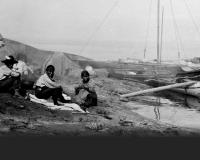Explore
On August 22, 1921, Chief Monfwi, representing all Tlicho, signed Treaty 11 with Canada. The Treaty promised to give the Tlicho annual payments and services, like medical care, education and old age care. In exchange, Canada would get title to the land, and would be free to allow gas and mineral...
Read moreThis bag is made from calf moose skin, sewn with sinew and lined with cotton fabric. A smoked, tanned moose hide collar holds a drawstring to pull the bag shut. This kind of bag is often called a meat bag as it was used to carry dry meat to eat while travelling and working on the land. It was...
Read moreThis Tłı̨chǫ landscape is known intimately to Tłı̨chǫ Elders. Trails, which are used year-round, provide access to a vast harvesting region, and link thousands of place names, each with a narrative of some form, sometimes many, inextricably bound to the place. Names and narratives...
Read moreIn the 19th and 20th century, the Canadian federal government's Indian Affairs department officially encouraged the growth of the Indian residential school system as a valuable agent in a wider policy of assimilating Aboriginal peoples in Canada into European-Canadian society.
A key goal...
Read moreBorn Madeleine Ink’ayamo in the Behchokǫ̀ region on June 14, 1889. On August 13, 1907, she married Benjamin Zoe, and had 11 children: Louis, Joseph, Veronique, Nicolas, Marie Adele, Sarah, Edward, Helen Margaret, Dora George, and Elizabeth.
Madeline is remember for many reasons but in...
Jimmy Bruneau was born on December 12, 1881, and raised on the land. After Chief Monfwi’s death in 1936, Jimmy Bruneau became the Chief. He understood that times were changing and that people needed the knowledge and skills that they could learn in school. He wanted children to be educated, but...
Read moreSacred waterfall. When one pays respect, the rainbow seen can predict the future.
Read moreWhen Europeans began living in North America there was enough land and resources so that all people could live together. HOWEVER as more and more Europeans arrived, tension over the land was created. The government at that time (British) created the Royal Proclamation to deal with this problem....
Read moreThere once lived an old woman and her young daughter. They had lived for so long in the same place, that they decided to move away to another location. So, one day they broke camp and prepared to leave. While they were packing, their dog died of old age. The woman and her daughter were very...
Read more










